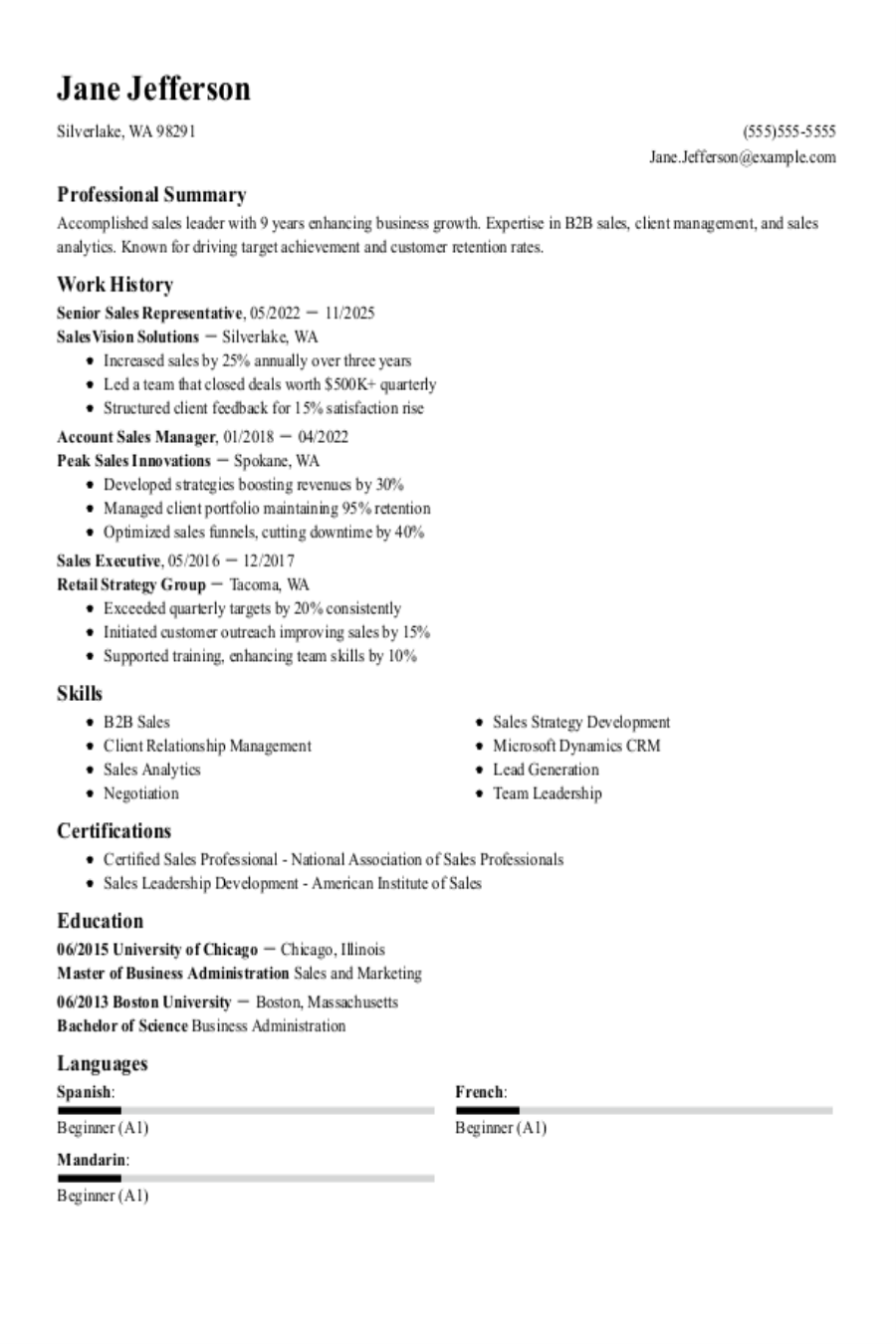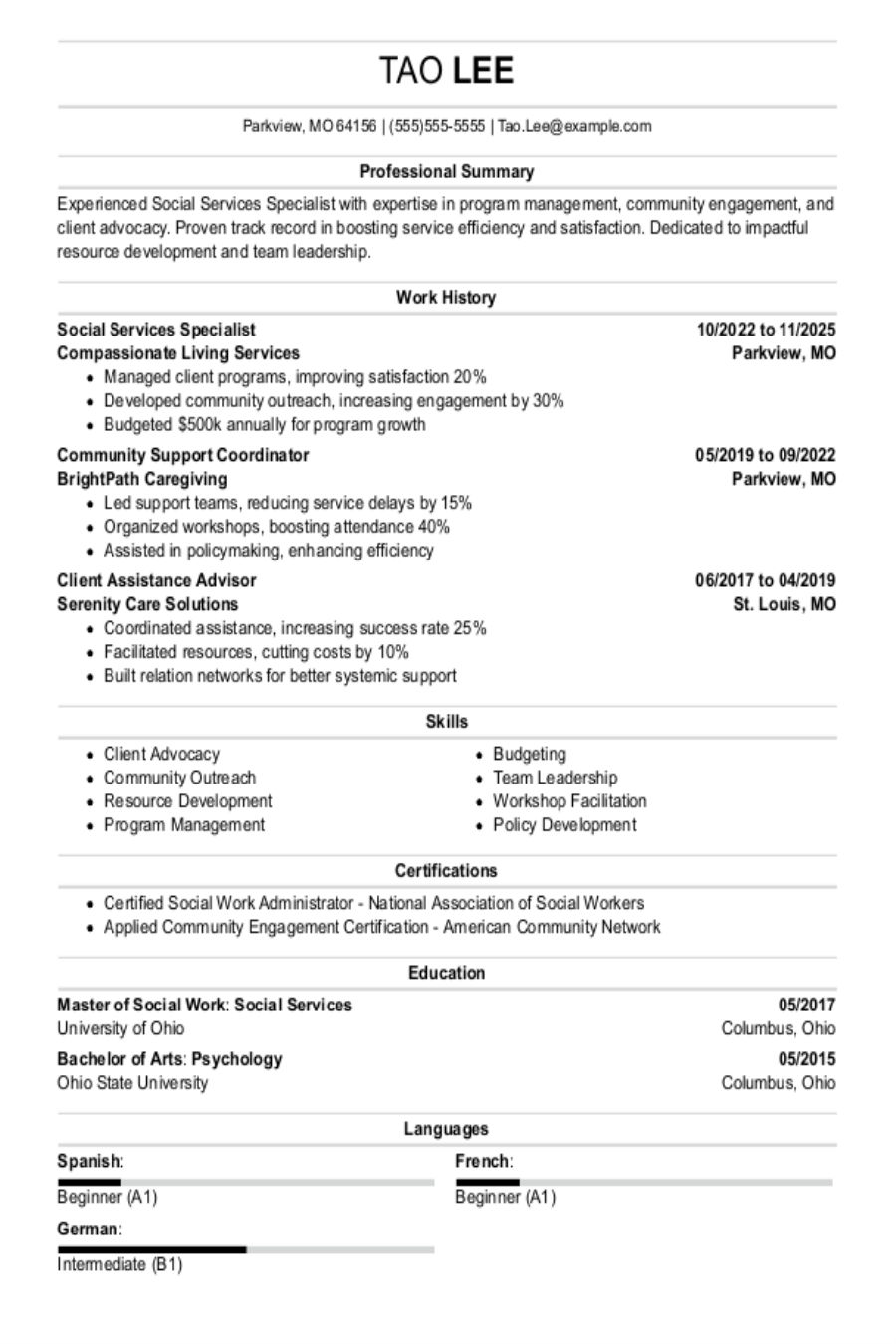Popular Video Game Designer Resume Examples
Entry-level video game designer resume
For an entry-level resume as a video game designer, it's important to showcase relevant projects, design skills, software expertise, and any coursework or certifications that highlight creativity and technical ability.
Places skills over experience: The functional resume format is strategic for this entry-level video game designer, as it highlights skills like AI scripting and game level design instead of emphasizing limited work history.
Emphasizes soft skills: This resume highlights strong soft skills in managing teams and cross-functional meetings, compensating for limited experience. The candidate's ability to boost player engagement through design innovations showcases their readiness for game design challenges.
Mid-career video game designer resume
A mid-career video game designer resume should emphasize a combination of creative projects, technical skills, and professional achievements to effectively demonstrate growth and expertise in the industry.
Includes mix of skills: This resume effectively highlights a mix of hard skills, like game design and UI/UX optimization, alongside soft skills such as collaboration and mentorship to present a well-rounded applicant.
Employs active language: action verbs such as "led," "designed," and "developed" convey initiative and measurable success, showcasing effective leadership in game design projects.
Experienced video game designer resume
An experienced video game designer resume should prioritize showcasing innovative projects and technical skills that highlight creativity and progression in the gaming industry.
Optimized for ATS: The resume uses a streamlined format featuring a professional header combined with an ATS-friendly resume layout, ensuring seamless navigation for recruiters and automated systems alike.
Highlights experience: The resume opens with a compelling summary that showcases the job seeker's extensive experience in video game design. This establishes a strong professional tone and immediately highlights their achievements in creating award-winning projects and improving user engagement.
No experience video game designer resume
A resume for an applicant with no experience as a video game designer should highlight relevant skills, personal projects, and any coursework to showcase creativity and passion for the gaming industry.
Draws from diverse experiences: Incorporating extracurricular activities and volunteer work improves a resume by demonstrating relevant skills and passion for the field, even when professional experience is limited.
Avoids jargon: Job seekers often feel the urge to embellish their roles with technical jargon or elaborate descriptions of minor tasks. However, a straightforward approach that highlights clear contributions and achievements proves to be more effective in showcasing one's skills and experiences.
More resume examples
Video Game Designer Resume Template
Looking to showcase your skills in the gaming industry? Start with this video game designer resume template, which you can easily adapt by filling it in with your personal details.
Caleb Carter Chen
Lakeside, CA 92508
(555)555-5555
Caleb Carter.Chen@example.com
Professional Summary
Creative video game designer enhancing player engagement. Expertise in game design and UI/UX with proven track record of project management. Mastered in latest game technologies and agile methodologies.
Work History
Video Game Designer
PixelForge Studios - Lakeside, CA
July 2023 - September 2025
- Increased player retention by 20%
- Led design for award-winning RPG game
- Improved game mechanics with 30% efficiency
Interactive Media Designer
Tech Visionary Games - San Francisco, CA
April 2021 - June 2023
- Developed MMO game increasing users by 45%
- Enhanced UI/UX, reducing feedback time by 50%
- Managed a budget of $500k for project
Junior Game Designer
Epic Play Creations - San Francisco, CA
January 2019 - March 2021
- Created level design for adventure titles
- Collaborated on sound design editing tools
- Optimized game assets reducing load times
Skills
- Game Design
- Level Design
- UI/UX Design
- 3D Modeling
- Project Management
- Unity
- C++
- Agile Methodologies
Certifications
- Certified Game Developer - International Game Developers Association
- Unity Game Developer Certification - Unity Technologies
Education
Master of Science Game Design and Development
University of Washington Seattle, Washington
June 2018
Bachelor of Arts Computer Science
University of California, Berkeley Berkeley, California
June 2016
Languages
- Spanish - Beginner (A1)
- French - Beginner (A1)
- Japanese - Beginner (A1)
Writing Your Video Game Designer Resume
Having explored these compelling resume examples, you are now prepared to dive into the intricacies of how to write a resume. We will assist you through each component, ensuring you understand every element in detail.
List your most relevant skills
An effective skills section on your video game designer resume must focus on both technical abilities, such as skill in game engines and programming languages, and essential soft skills like creativity and teamwork. These elements should be tailored to reflect the specific requirements of the keywords from the job listing you’re applying for.
Incorporating these keywords makes it easier for human recruiters to see your fit for the position and helps applicant tracking systems recognize you as a strong job seeker. By aligning your skills with those outlined in the job description, you demonstrate that you understand what the employer values most in a video game designer.
Example of skills on a video game designer resume
- Proficient in using game design software (Unity, Unreal Engine) to create engaging gameplay
- Skilled in developing compelling narratives and characters
- Strong collaborative skills with a passion for teamwork
- Creative thinker with a keen eye for detail and aesthetics
The skills section offers you a chance to highlight technical skills that prepare you for the video game designer role. Incorporate relevant abilities listed in the job description, along with key soft skills such as teamwork and creativity, to show your readiness to address the challenges of this position.
Highlight your work history
Your work experience section should describe your work history while highlighting the achievements that demonstrate your creativity and technical skills. Use this section to showcase how you contributed to successful projects, integrating action verbs and relevant industry keywords throughout.
For each job entry, ensure you include critical information such as your title, the name of the employer, and the dates of employment. This context helps hiring managers quickly assess your background. Additionally, focus on specific accomplishments—like the games you worked on or innovative features you developed—to make each entry more compelling.
Example of a video game designer work experience entry
- Video Game Designer
Epic Games - Cary, NC
June 2019 - Present - Design and develop engaging game mechanics for multiple platforms, improving player experience and increasing user retention by 30%
- Collaborate with artists and programmers to create visually stunning environments, resulting in a 25% increase in positive reviews on gaming platforms
- Conduct playtesting sessions to gather feedback, leading to iterative improvements that elevated gameplay satisfaction scores by 15%
- Mentor junior designers on industry best practices and tools, improving team efficiency and reducing project turnaround time by 20%
- Use analytics to inform design decisions, optimizing features based on player data which boosted overall game engagement metrics.
Aim for clarity in your resume bullet points. Use concise language that highlights measurable achievements, ensuring each point conveys impact without unnecessary elaboration. Keep it focused and relevant to your desired role.
Add portfolio work to your resume
For video game designers, it’s important to showcase your creative projects while inviting hiring managers to explore your full portfolio. Your resume should illustrate your design skills and unique contributions to various games, prompting potential employers to delve deeper.
Place a link to your portfolio prominently at the top of your resume, right under your contact details. Consider adding a Portfolio Highlights section that briefly describes 3-4 standout projects, emphasizing the impact of your work in terms of user engagement or gameplay mechanics.
Example of a portfolio highlights section
- Fantasy RPG Development for Epic Games – Designed engaging gameplay mechanics that increased player retention by 25%
- Mobile Game Prototype for Indie Studio – Created a unique art style and user interface, resulting in a successful pitch to investors
- Level Design for Horror Survival Project – Developed immersive environments praised for their tension and atmosphere at industry showcase
- Interactive Storytelling Features for Adventure Co. – Implemented branching dialogue systems leading to a 40% increase in player choices
Include your education
The education section of your video game designer resume should list your academic credentials in reverse-chronological order starting with your most recent degree. Include relevant degrees, diplomas, and certifications while omitting your high school diploma if you hold a higher qualification. Mentioning any honors or specific projects during your studies that relate directly to video game design can also be beneficial.
If you are currently enrolled in a program or have not yet completed your degree, indicate the highest level achieved along with an expected graduation date. You may choose to include bullet points highlighting coursework or notable projects that demonstrate skills relevant to game design, especially if you're a beginner candidate or current student.
Common certifications for a video game designer resume
- Certified Game Designer (CGD) – International Game Developers Association (IGDA)
- Unity Certified Developer – Unity Technologies
- Certified ScrumMaster (CSM) – Scrum Alliance
- Game Design and Development Specialization – Coursera/University of Colorado Boulder
Sum up your resume with an introduction
Creating a compelling profile section on your resume is important as it serves as your first opportunity to make a strong impression on potential employers. A well-crafted profile quickly conveys your professional identity and sets the tone for the rest of your application, helping you stand out in a competitive job market.
If you are an experienced job seeker, consider using a professional summary to showcase your achievements and expertise. This approach allows you to highlight key accomplishments that directly relate to the position you’re applying for. If you lack extensive experience, including a career-oriented resume objective can help frame your resume for potential employers.
Professional summary example
Innovative video game designer with over 5 years of experience developing engaging gameplay experiences across multiple platforms. Demonstrated success in leading projects from concept to launch, improving user engagement through intuitive mechanics and captivating storytelling. Proficient in game development software and collaborative team dynamics, consistently delivering high-quality products on schedule.
Resume objective example
Enthusiastic video game designer eager to use creativity and problem-solving skills to develop engaging gaming experiences. Looking to contribute fresh ideas and technical expertise in a collaborative environment, improving user enjoyment and driving innovation.
As a video game designer, your resume profile is important for making a strong first impression. Make sure to carefully analyze the job description and weave in relevant keywords that highlight your skills and experiences. This approach not only showcases your qualifications but also improves your chances of passing through ATS filters used by many employers.
Add unique sections to set you apart
Optional resume sections can help you stand out as a video game designer by highlighting your unique qualifications. These sections offer a platform to showcase skills and experiences that make you the ideal applicant.
Including hobbies that align with game design or volunteer work in tech-related fields can provide valuable insights into your personality and work ethic. This gives employers a glimpse into how you spend your time outside of work, emphasizing creativity and commitment to self-improvement.
Three sections perfect for a video game designer resume
- Work Samples: A portfolio section is important for a video game designer's resume, as it showcases your unique creative talents. Include 3-5 standout projects, detailing your role and the innovative solutions you implemented to improve gameplay experiences.
- Client Testimonials: Incorporating client testimonials into your resume can set you apart in the creative field. Choose a few strong quotes that showcase your unique skills, such as innovation and collaboration, to demonstrate your value effectively.
- Awards and Recognition: Showcasing awards on your resume can improve your appeal to potential employers. Include relevant accolades, such as industry honors or game design competitions, along with the organization and year they were awarded.
5 Resume Formatting Tips
- Choose a format that matches your career stage.
Selecting the appropriate resume format is important for highlighting your skills. If you’re just starting out, consider a functional resume to emphasize your abilities. For those with more experience, using a chronological format can effectively display your career progression. A combination resume provides a balanced approach if you have varied experiences.
- Pick a smart resume template.
Using a professional resume template can greatly improve your document's readability. Templates streamline formatting, making it easy for hiring managers to quickly scan your qualifications. If you choose a custom layout, ensure it stays clean and employs ATS-friendly fonts to avoid any potential pitfalls in the application process.
- Select an appropriate font.
Choosing the right colors for your resume can improve readability. Stick to a neutral palette with one or two accent colors to highlight key sections without overwhelming the reader. Additionally, using a professional font can further improve the overall presentation of your resume.
- Use consistent formatting.
Align your resume to the left and maintain uniform margins. This creates a polished look that improves readability and showcases your attention to detail.
- Keep your resume to one or two pages.
When crafting your resume, remember that resumes should be one page long. If you have extensive experience, a two-page format is acceptable. Keep your content concise and focused on showcasing key skills and achievements.
Tools for Your Job Search
Are you excited to apply for that dream video game designer position? Before you hit send on your application, take a moment to use our ATS Resume Checker. This tool provides essential feedback on how your resume performs against the automated systems used by many gaming companies, ensuring you stand out in a competitive market.
Looking to elevate your resume even further? Our AI Resume Builder is here to help! It offers tailored recommendations based on your specific gaming experience and skills, along with professionally designed templates that showcase your creativity and technical expertise effectively.
Frequently Asked Questions
Last Updated: October 1, 2025
Absolutely. A cover letter is important because it adds depth to your resume and offers another chance to connect with potential employers. This is your opportunity to express what draws you to the role of video game designer and how your unique experiences make you an ideal applicant. Don’t overlook this chance—write a cover letter that improves your application.
For a quick and effective solution, check out our AI Cover Letter Generator. It allows you to create tailored cover letters in minutes, complete with options for a cover letter template that matches your resume style perfectly, ensuring you present yourself professionally and cohesively.
A CV (curriculum vitae) is generally longer and more detailed than a resume. Resumes typically span one to two pages, while CVs can extend several pages, providing in-depth information about your academic background, research accomplishments, and professional experiences.
You’ll want to use a CV for specialized roles in academia, science, law, or medicine. If you need to create a CV for your next opportunity, our online CV Maker is here to help you produce a tailored document quickly. With various CV templates designed for different industries and career levels, crafting your ideal CV has never been easier!
When addressing gaps on your resume, be honest about the reasons behind them. Clearly explain what led to the time away from work and highlight any productive activities you engaged in, such as courses or freelance projects. This approach shows potential employers that you used the time wisely. After explaining, shift the focus back to your qualifications and experiences to demonstrate your value.
To craft an effective skills section as a video game designer, integrate technical skills such as programming and graphic design with soft skills like teamwork and creativity. In your experience section, illustrate how you applied these skills in projects to improve gameplay or streamline development processes, showcasing tangible results.
For a video game designer, maintaining an active LinkedIn profile is important. It allows you to connect with industry professionals and highlight your creative skills effectively.
Was this information helpful? Let us know!
Leisha is a career industry editor dedicated to helping job seekers excel in their careers.
More resources

Still in the Game: 9 in 10 Older Workers Are Upskilling to Stay Competitive
The idea that older workers are resistant to change doesn t ho...

The AI Boss Effect: 97% of Workers Have Asked ChatGPT for Advice Instead of Their Manager
Resume Now s latest report explores how AI is replacing manage...

37 Unique Skills to Put on Your Resume
Trying to avoid the skills you see pop up on resumes repeatedl...

Senior Sales Representative Resume: Examples, Sample & Skills
Ready to drive unparalleled sales success? Our senior sales re...

Social Work Resume: Examples, Templates & Tips
Start advancing your social work career with a polished resume...


